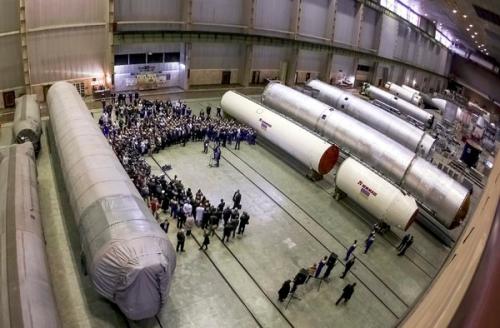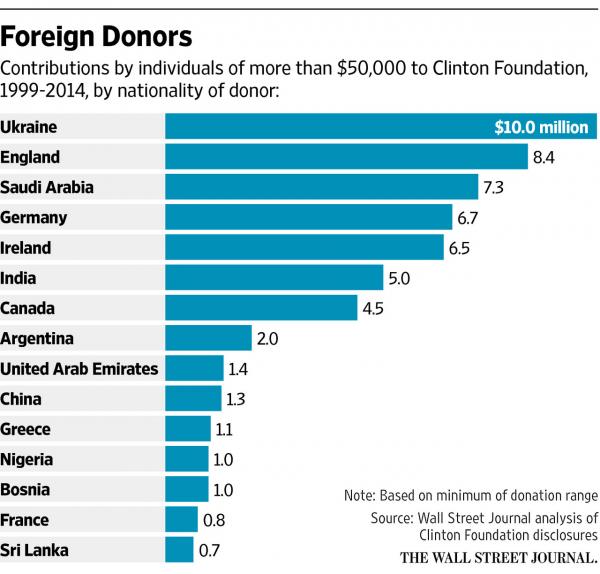SOL:
Russian Missile Engines are the best in the world, including the space
missile engines, so much so that the US' NASA Space Program uses Russian
engines exclusively. The US has made Russia its "evil enemy" simply
because Russia refuses to be a vassals of the US like the EU so the Deep
State, the Military arms complex, and the Neocons will even go to WWIII
to destroy that Russian resistance. Russia seems to out maneuver the
WEST at every turn, which is the reason for implementing Russian
sanctions to force Europe to buy US's more expensive and unreliable
NATURAL gas (LPG) from the US market instead of decades of very
efficient and effective pipeline delivery system at a much greater
reduction in cost.
NYT Shocking Report: US "Ally" Ukraine Is Source Of North Korean Missile Engines
By Tyler Durden
August 14, 2017 "Information Clearing House" - When
the US State Department supported Ukraine domestic forces and
nationalist elements to stage a successful and deadly coup against then
pro-Russian president Viktor Yanukovych in 2014, the outcome was
supposed to be a nation that is a undisputed US ally and persistent
threat, distraction and non-NATO opponent to bordering Russia. Instead,
it now appears that it has been Ukraine which was, as the NYT writes, the secret behind the success of North Korea's ballistic missile program.
Specifically, in a blockbuster report this morning, the NYT alleges that
North Korea has been making black-market purchases of powerful rocket
engines from a Ukrainian factory citing "expert analysis being published
Monday and classified assessments by American intelligence agencies."
The studies may solve the mystery of how North Korea began succeeding so suddenly after a string of fiery missile failures, some of which may have been caused by American sabotage of its supply chains and cyberattacks on its launches. After those failures, the North changed designs and suppliers in the past two years, according to a new study by Michael Elleman, a missile expert at the International Institute for Strategic Studies.
According to the report, analysts who studied photographs of Kim Jong-un, inspecting the new rocket motors concluded that they
derive from designs that once powered the Soviet Union’s missile fleet.
"The engines were so powerful that a single missile could hurl 10
thermonuclear warheads between continents."
Since the alleged engines have been linked to only a few former Soviet sites, government investigators and experts have
focused their inquiries on a missile factory in Dnipro, Ukraine, on the
edge of the territory where Russia is fighting a low-level war to break
off part of Ukraine. During the Cold War, the factory made the
deadliest missiles in the Soviet arsenal, including the giant SS-18. It
remained one of Russia’s primary producers of missiles even after
Ukraine gained independence.
Ukraine President Poroshenko visiting the Yuzhmash plant in Dnipro in 2014
"The factory is underused, awash in unpaid bills and low morale. Experts believe it is the most likely source of the engines that in July powered the two ICBM tests, which were the first to suggest that North Korea has the range, if not necessarily the accuracy or warhead technology, to threaten American cities."In other words, it is America's latest Eastern European "ally" that is behind what is rapidly emerging as a potential nuclear threat that can blanket as much as half of the continental US.
“It’s likely that these engines came from Ukraine — probably illicitly,” Elleman told the NYT in an interview. “The big question is how many they have and whether the Ukrainians are helping them now. I’m very worried.”
Considering Ukraine is a close US ally - just ask John McCain - maybe a phone call to current Ukraine president, oligarch billionaire Poroshenko, should suffice?Bolstering his conclusion, he added, was a finding by United Nations investigators that North Korea tried six years ago to steal missile secrets from the Ukrainian complex. Two North Koreans were caught, and a U.N. report said the information they tried to steal was focused on advanced “missile systems, liquid-propellant engines, spacecraft and missile fuel supply systems.” Investigators now believe that, amid the chaos of post-revolutionary Ukraine, Pyongyang tried again.
To
be sure, the factory itself would never admit this stunning allegation:
last month, Yuzhmash denied reports that the factory complex was
struggling for survival and selling its technologies abroad, in
particular to China. Its website says the company does not, has not and
will not participate in “the transfer of potentially dangerous
technologies outside Ukraine.”
Making matters worse of the US "allies" in Ukraine, American investigators do not believe that denial, though
they say there is no evidence that the government of President Petro O.
Poroshenko, who recently visited the White House, had any knowledge or
control over what was happening inside the complex. The obvious implication here is that - if accurate - Ukraine had been working with North Korea for years, well into the administration of Barack Obama, the same president under whom the Ukraine coup was greenlight, which would also suggest that the current North Korean crisis is explicitly a consequence of Obama's foreign policies.
Which is why we read the following amusing disclaime in the NYT: "How the Russian-designed engines, called the RD-250, got to North Korea is still a mystery."
Furthermore,
Elleman told the NYT that the fact that the powerful engines did get to
North Korea, despite a raft of United Nations sanctions, suggests a
broad intelligence failure involving the many nations that monitor
Pyongyang. Failure or perhaps just US intel closing its eyes to what
Ukraine may be doing through the back door.
The
NYT writes that "it is unclear who is responsible for selling the
rockets and the design knowledge, and intelligence officials have
differing theories about the details. But Mr. Elleman makes a
strong circumstantial case that would implicate the deteriorating
factory complex and its underemployed engineers. “I feel for
those guys,” said Mr. Elleman, who visited the factory repeatedly a
decade ago while working on federal projects to curb weapon threats.
“They don’t want to do bad things.”
One can only imagine what Elleman would "feel for those guys" if the factory turned out to be Russian, or Chinese.
No Advertising - No Government Grants - This Is Independent Media
|
Economically, the plant and design bureau faced new headwinds after Russia in early 2014 invaded and annexed Crimea, a part of Ukraine. Relations between the two nations turned icy, and Moscow withdrew plans to have Yuzhmash make new versions of the SS-18 missile. In July 2014, a report for the Carnegie Endowment for International Peace warned that such economic upset could put Ukrainian missile and atomic experts “out of work and could expose their crucial know-how to rogue regimes and proliferators.”
It was right: The
first clues that a Ukrainian engine had fallen into North Korean hands
came in September when Mr. Kim supervised a ground test of a new rocket
engine that analysts called the biggest and most powerful to date.
Norbert Brügge, a German analyst, reported that photos of the engine
firing revealed strong similarities between it and the RD-250, a
Yuzhmash model.
Alarms rang louder after a second ground firing of the North’s new engine, in March, and its powering of the flight in May of a new intermediate-range missile, the Hwasong-12. It broke the North’s record for missile distance. Its high trajectory, if leveled out, translated into about 2,800 miles, or far enough to fly beyond the American military base at Guam.
On June 1, Mr. Elleman struck an apprehensive note. He argued that the potent engine clearly hailed from “a different manufacturer than all the other engines that we’ve seen.”Mr. Elleman said the North’s diversification into a new line of missile engines was important because it undermined the West’s assumptions about the nation’s missile prowess: “We could be in for surprises.”
That is exactly what happened. The first of the North’s two tests in July of a new missile, the Hwasong-14, went a distance sufficient to threaten Alaska, surprising the intelligence community. The second went far enough to reach the West Coast, and perhaps Denver or Chicago.
If
the NYT report is accurate, perhaps it is time to re-evaluate the logic
behind ongoing US support of Ukraine: as a reminder, two weeks ago the WSJ reported that Pentagon and State Department officials have
devised plans to hit Russia where it hurts the most, and supply Ukraine
with antitank missiles and other weaponry, and are now seeking White
House approval at a time when ties between Moscow and Washington are as
bad as during any point under the Obama administration. In
light of the news that Ukraine may be responsible for weaponizing the
biggest nuclear threat to the US, perhaps it might not be a bad idea to
"delay" or maybe even this deadly support for Ukraine, even if it means
an outpouring of fury from neo-cons like John McCain.
* * *
Finally, in light of the above, perhaps it is time to re-address the following article from March 2015: "Clinton Foundation’s Deep Financial Ties to Ukrainian Oligarch Revealed"
which based on a WSJ report, showed that more than any other nation, it
was Ukraine donors that were the most generous, especially the Victor
Pinchuk foundation: "Between 2009 and 2013, including when Mrs. Clinton
was secretary of state, the Clinton Foundation received at least $8.6
million from the Victor Pinchuk Foundation, according to that
foundation, which is based in Kiev, Ukraine. It was created by Mr.
Pinchuk, whose fortune stems from a pipe-making company. He served two
terms as an elected member of the Ukrainian Parliament and is a
proponent of closer ties between Ukraine and the European Union."
As the WSJ reported at the time:In 2008, Mr. Pinchuk made a five-year, $29 million commitment to the Clinton Global Initiative, a wing of the foundation that coordinates charitable projects and funding for them but doesn’t handle the money. The pledge was to fund a program to train future Ukrainian leaders and professionals “to modernize Ukraine,” according to the Clinton Foundation. Several alumni are current members of the Ukrainian Parliament.The Pinchuk foundation said its donations were intended to help to make Ukraine “a successful, free, modern country based on European values.” It said that if Mr. Pinchuk was lobbying the State Department about Ukraine, “this cannot be seen as anything but a good thing.”

No comments:
Post a Comment